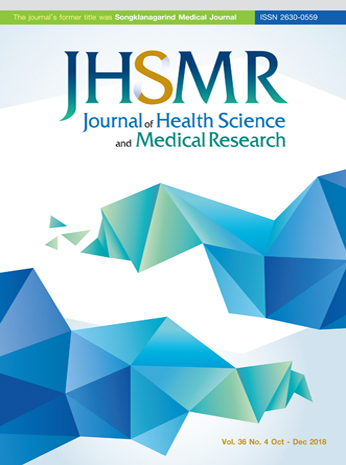Prevalence of the Z515 (Palliative Care) Diagnosis from the ICD-10 System in Cancer Patients and the Relationship between Treatment and Cost in Songklanagarind Hospital
DOI:
https://doi.org/10.31584/jhsmr.201824Keywords:
ICD10, Z515, palliative, prevalenceAbstract
Objective: To determine the prevalence of use of the diagnostic system ICD-10 code Z515 in patients diagnosed with cancer and the relationship between treatment and cost in Songklanagarind Hospital during the 2012-2016 period.
Material and Methods: A retrospective descriptive study was performed in patients who were diagnosed as code Z515 in Songklanagarind Hospital from 2012-2016. Data were collected through the Hospital Information System (HIS), and the patients were divided into 2 groups based on whether they were Inpatient Department (IPD) or Outpatient Department (OPD). From the HIS, data concerning sex, age, the right of access to healthcare services, date of diagnosis, first and last department that diagnosed the Z515 code, other departments that diagnosed the same code, other codes diagnosed besides Z515, the latest treatment received, number of regularly-used medications, symptoms that persisted according to the most recent record, ward name, duration of hospitalization (for IPD cases), and the average cost of treatment were recorded on data extraction forms and analyzed as percentages with 95% confidence interval and odds ratios.
Results: The prevalence of the diagnostic code Z515 in cancer patients during the study period was 0.2% in both inand outpatients. For outpatient the relationship between average cost and number of medications and average cost and type of treatment were statistically significantly different, while for inpatients the difference was not statistically significant.
Conclusion: In Songklanagarind Hospital the use of code Z515 is very low, even though we know that all cancer patients should get the best palliative care support and the earlier we diagnose them as palliative, the better the care they will receive. Therefore, if the doctors are aware of this code, the patient will receive the best care in their end stages of life, and that would make them and their families feel happier. Moreover, our hospital will get reimbursement from the government to get more resources. Hence, more patients can be helped. Songklanagarind Hospital should undertake some kind of program to ensure all physicians are aware of code Z515 and how to use it in order to provide the best care for end-of-life patients.
References
Available from: https://www.gotoknow.org/posts/462619
2. Etda.or.th. What’s standard to use ICD-10? [homepage on the Internet]. Bangkok: ETDA; 2015 [cited 2017 Mar 10].
Available from: https://www.etda.or.th/content/1231.html
3. The right to health care services for Thai people [homepage on the Internet]. Bangkok: National Health Security Office;2015 [cited 2017 Mar 10]. Available from: https://www.nhso.go.th/FrontEnd/page-contentdetail.aspx?CatID=MTAyNQ
4. Guidelines for end of life care [homepage on the Internet]. Nonthaburi: Department of Medical Service. Ministry of Public Health; 2014 [cited 2017 Mar 10]. Available from: https://www.dms.moph.go.th/dmsweb/cpgcorner/endoflifecare.pdf
5. Definition of palliative care [homepage on the Internet]. Geneva: WHO; 2002 [cited 2017 Mar 10]. Available from:
https://www.who.in.int/cancer/palliative/definition/en/
6. Thomas K. Prognostic indicator guidance. 4th ed [monograph on the Internet]. London: The Gold Standards Framework Centre; 2011 [cited 2017 Mar 10]. Available from: https://www.goldstandardsframework.org.uk/cdcontent/uploads/files/General%20Files/Prognostic%20Indicator%20Guidance%20October%202011.pdf
7. Pattanareungli A. List disease of Palliative care and Functional unit [homepage on the Internet]. Nonthaburi: Department of Medical Service. Ministry of Public Health; 2016 [cited 2017 Mar 10]. Available from: https://www.dms.moph.go.th/dmsweb/cpgcorner/cpgcorner26122559.pdf
8. White MC, Holman DM, Jennifer E, Peipins LA, Grossman M, Henley SJ. Age and cancer risk: a potentially modifiable
relationship. Am J Prev Med 2014;46(3 Suppl 1):S7-15.
9. NCCN.org. National guideline for cancer treatment [homepage on the Internet]. Washington: Washington National Comprehensive Cancer Network; c2016-17 [cited 2017 Mar 13]. Available from: https://www.nccn.org/professionals/physician_gls/pdf/aml.pdf
10. Cancer.org. Osteosarcoma treatment [homepage on the Internet]. Atlanta: The American Cancer Society; c2012-13 [cited 2017 Mar 13]. Available from: https://www.cancer.org/cancer/osteosarcoma/treating.html
11. Lynch T, Connor S, Clark D. Mapping levels of palliative care development: a global update. J Pain Symptom Manage 2013;45:1094-10.
12. Seya MJ, Gelders SFAM, Achara OU, Milani B, Scholten WK. A first comparison between the consumption of and theneed for opioid analgesics at country, regional and global level. J Pain Palliat Care Pharmacother 2011;25:6-18.
13. American Cancer Society. Cancer facts & figures 2016 [homepage on the Internet]. Atlanta: American Cancer Society;2016 [cited 2017 Mar 10]. Available from: https://www.cancer.org/content/dam/cancer-org/research/cancer-facts-andstatistics/annual-cancer-facts-and-figures/2016/cancerfacts-and-figures-2016.pdf























